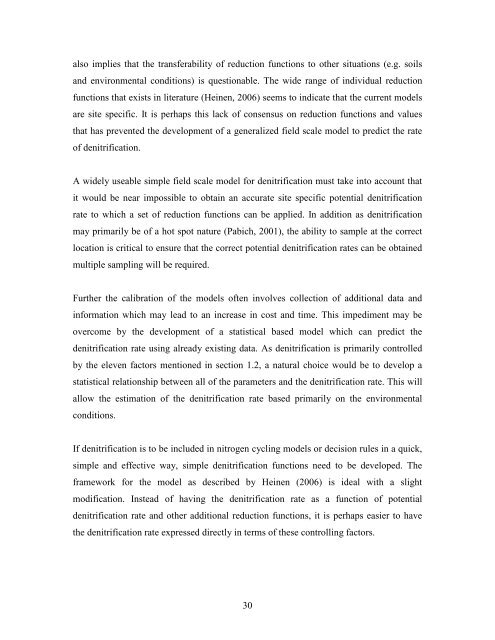THE FLORIDA STATE UNIVERSITY ARTS AND SCIENCES ...
THE FLORIDA STATE UNIVERSITY ARTS AND SCIENCES ...
THE FLORIDA STATE UNIVERSITY ARTS AND SCIENCES ...
You also want an ePaper? Increase the reach of your titles
YUMPU automatically turns print PDFs into web optimized ePapers that Google loves.
also implies that the transferability of reduction functions to other situations (e.g. soils<br />
and environmental conditions) is questionable. The wide range of individual reduction<br />
functions that exists in literature (Heinen, 2006) seems to indicate that the current models<br />
are site specific. It is perhaps this lack of consensus on reduction functions and values<br />
that has prevented the development of a generalized field scale model to predict the rate<br />
of denitrification.<br />
A widely useable simple field scale model for denitrification must take into account that<br />
it would be near impossible to obtain an accurate site specific potential denitrification<br />
rate to which a set of reduction functions can be applied. In addition as denitrification<br />
may primarily be of a hot spot nature (Pabich, 2001), the ability to sample at the correct<br />
location is critical to ensure that the correct potential denitrification rates can be obtained<br />
multiple sampling will be required.<br />
Further the calibration of the models often involves collection of additional data and<br />
information which may lead to an increase in cost and time. This impediment may be<br />
overcome by the development of a statistical based model which can predict the<br />
denitrification rate using already existing data. As denitrification is primarily controlled<br />
by the eleven factors mentioned in section 1.2, a natural choice would be to develop a<br />
statistical relationship between all of the parameters and the denitrification rate. This will<br />
allow the estimation of the denitrification rate based primarily on the environmental<br />
conditions.<br />
If denitrification is to be included in nitrogen cycling models or decision rules in a quick,<br />
simple and effective way, simple denitrification functions need to be developed. The<br />
framework for the model as described by Heinen (2006) is ideal with a slight<br />
modification. Instead of having the denitrification rate as a function of potential<br />
denitrification rate and other additional reduction functions, it is perhaps easier to have<br />
the denitrification rate expressed directly in terms of these controlling factors.<br />
30
















